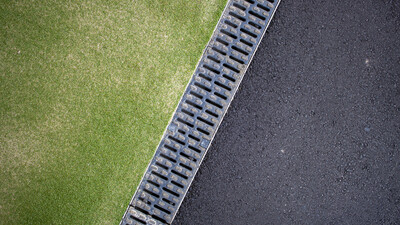Channel drains are a familiar sight in all kinds of environments, yet often go unnoticed until something goes wrong. Designed to handle the efficient drainage of surface water across large areas, they’re an essential part of any external drainage system, whether at a domestic driveway or a commercial distribution centre. But like any drainage product, they need proper care to remain effective.
Join us as we look at the best ways to keep them clean and working at peak performance.
What Are Channel Drains?
Channel drains, sometimes called linear drains or trench drains, are long, narrow drainage systems designed to quickly remove water from large flat surfaces. They are typically installed flush with the surrounding surface, with a grate covering the open channel to prevent debris from falling in.
They come in various sizes, load classes and materials to suit different applications. Domestic-grade channel drains might be used to prevent water pooling on a patio, driveway or in front of a garage door, while high-capacity options are used at industrial facilities, loading bays, ports and even airports. The design may be modular for ease of installation and cleaning, with grates made from galvanised steel, ductile iron, or reinforced plastic, depending on the loading requirements.
Water enters the drain through the grate, is channelled along the length of the system, and exits via a connected underground drainage pipe or soakaway. In systems with a built-in fall, the internal base of the channel gently slopes to encourage faster water flow and reduce sediment build-up.
What Happens If You Don’t Maintain Channel Drains?
Despite their robust appearance, channel drains can easily become clogged if they’re not maintained properly. Silt, leaves, litter, grit, moss and even vehicle oil or fat deposits (in commercial settings) can all accumulate over time. This build-up restricts the water flow, reducing the drain’s efficiency and potentially causing surface flooding.
Blocked channel drains also contribute to freeze-thaw damage in colder months, as standing water expands in freezing temperatures and cracks surrounding surfaces. In high-traffic areas, pooling water can increase slip hazards and damage paving, tarmac or concrete. Worse still, unmanaged drainage issues may breach building regulations or local authority environmental controls, especially if run-off enters public roads or causes downstream flooding.
For businesses, this can mean disruption, insurance claims and unnecessary repair costs. For homeowners, it can mean the unsightly return of water to patios and garages just when they were meant to be dry.
Cleaning and Maintenance Tips
Regular cleaning and inspection are the key to keeping your channel drains functioning efficiently. Here’s how to do it:
Schedule routine inspections
As a minimum, channel drains should be checked twice a year – ideally in spring and autumn. After heavy storms or visible pooling, inspect them more frequently. Remove the grates and check for any visible obstructions or sediment build-up.
Remove debris manually
Use a trowel or gloved hand to remove any compacted dirt, leaves or gravel from inside the channel. For longer systems, a drain rod or pressure washer can help dislodge material from hard-to-reach areas.
Flush the channel
After debris has been removed, flush the system with water to carry away any loose particles. For stubborn dirt, a hose with a jet nozzle or a low-powered pressure washer can help restore full flow.
Clean the grates
Grates should be removed and cleaned separately using warm soapy water and a stiff brush. If metal grates are showing signs of rust or damage, consider replacing them to preserve the structural integrity of the drain.
Check for damage
While the grate is off, inspect the channel body for signs of cracking, erosion or displacement. Ensure that the outlet connection is still firmly joined to the downstream pipe or soakaway. Any structural damage should be repaired promptly to avoid undermining the system.
Keep nearby areas tidy
One of the easiest ways to maintain a clean channel drain is to reduce the amount of debris entering it in the first place. Sweep surrounding areas regularly and keep trees trimmed to minimise falling leaves.
Be mindful of what enters the drain
Don’t allow oil, paint, cement washout or chemical residues to enter the system. These not only cause blockages but can damage the internal surface of the drain and harm local waterways.
Consider a silt trap or catch basin
In systems with high flow or heavy use, especially where vehicle traffic is involved, installing a silt trap or sediment interceptor upstream can reduce the burden on the channel and prolong maintenance intervals.
Keeping Channel Drains Working at Their Best
Whether draining a garden patio or keeping a commercial yard flood-free, channel drains play a vital role in managing surface water. But their efficiency depends on how well they are maintained. Cleaning them regularly, staying alert to signs of clogging, and acting quickly when problems arise will keep your drains running smoothly—and help you avoid much bigger headaches in the future.
If you’d like help choosing the right type of channel drain for your site or advice on keeping it maintained, contact Drainfast’s technical team today on 01420 555600.

Written by
Bob Stone
Technical Sales
Heading up our Technical Estimating Department, Bob is our in-house quantity surveyor.

